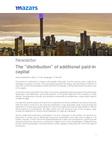
The "distribution" of additional paid-in capital
The "distribution" of additional paid-in capital
The premium in placement of shares is the greater value paid -over the nominal value- made by an associate in an issue of shares. This value becomes part of the equity, and according to Article 91 of Law 1607 of 2012 (incorporated to Article 36 of the Tax Statute), it will be governed by the same rules of the capital.
On the other hand, Article 98 of the Code of Commerce establishes that the purpose of the partnership agreement is the distribution, among the partners, of the profits obtained in the company or social activity. The distribution of profits, as a dividend, is taxed with the dividend tax, unless certain specific exceptions apply.
It is clear then that the nature of the premium in placement of shares is different from that of the profit; while the former comes from the external contributions of the associates, does not go through the statement of income and is governed by the rules of the capital (and may be reduced with or without reimbursement of contributions); the latter comes from the economic cycle of the company, goes through the statement of income and its distribution is made as a dividend.
Having made these preliminary clarifications, it is then necessary to ask whether the premium on placement of shares may be distributed among the shareholders and under what conditions. The answer, logically, is that it cannot be distributed because it does not correspond to a profit received during the economic cycle but to a contribution made by one or more shareholders. A different thing is that it can be reimbursed, in the same terms in which capital is reimbursed (Art. 145 of the Code of Commerce).
The above question arises from the provisions of Article 895 of the Tax Statute, incorporated to this ordinance by Article 69 of Law 1943 of 2018 where, when regulating the treatment of dividends distributed to Colombian Holding Companies (CHC), it is established that "the distribution of the premium in placement of shares, which does not constitute fiscal cost, will have the same treatment as ordinary dividends, being configured as exempt income when the beneficiary is a CHC (...)".
After reading this regulatory fragment, the following questions immediately arise: How can the premium on placement of shares be distributed if it does not come from profits, how can the premium on placement of shares be distributed if it has the same treatment as capital, could, under this logic, then the capital also be distributed among the shareholders as a dividend, how can the premium have the same treatment as the capital, and how can the capital also be distributed among the shareholders as a dividend? How can the premium have the same treatment as dividends, if the premium is a higher value paid for some shares in an issue and the dividends are the profit distributed, would withholding tax on dividends be applied to the supposed distribution of the premium in placement of shares? Since these questions do not have a logical answer, it is essential to understand that the aforementioned regulatory premise is based on a misunderstanding of the nature of the equity accounts.
Perhaps this error has been -at some point- shared by other state entities, which does not detract from its condition of error. According to Official Communication 220-050194 of March 6, 2017, the Superintendence of Companies established that "to dispose of the placement premium, the highest corporate body shall have to meet in accordance with the terms of law and the bylaws and observe the special majorities for the distribution of this surplus (...)".
It is curious that, in order to reach this conclusion, this Official Letter takes as support Official Letter AN 09195 of April 23, 1990, which indicates that "the premium in placement of shares, although it does not properly obey the concept of profit, understanding this as the greater income against the expenses in the exercise of the social enterprise during a determined period (social exercise), it is a capital surplus and therefore a component of the social patrimony (...)".
Fortunately, very quickly (a couple of days later), through Oficio 220-061029 of March 22, 2017, the Superintendence of Companies tacitly repealed the referred Oficio by stating that "from the study of the impact of the tax law on the commercial law, the Superintendence of Companies has revised the doctrine that considered the premium as a profit and, instead, based on articles 384 and 386 of the commercial statute, has concluded that the premium in placement of shares is part of the contribution delivered by the partner or shareholder to the company".
In conclusion, the premise established by the third paragraph of article 895 of the Tax Statute, incorporated through article 69 of Law 1943 of 2018, according to which the distribution of the premium will have the same treatment as the ordinary dividends, is conceptually - and logically - wrong.


